It's weird to think that, with all the scientific advancements we have in 2016, like reusable rockets, and the ability to clone dead dogs, we still don't really understand how most major diseases work when you get down to the molecular level.
But Australian scientists have developed a new technique that can actually track the interaction and movement of proteins in a cell for the first time, and could help researchers develop new treatments for cancer and other diseases.
The technique is called BiCAP (Bimolecular Complementation Affinity Purification) and uses tiny nanoparticles to visualise and isolate protein complexes in breast cancer cells.
Using BiCAP, the team can see when proteins interact with other proteins to form a complex, and then track their movement.
This is important because proteins, in addition to just being what your swole friend uses to bulk up, are also what make up the majority of cellular processes in our bodies.
And if we can understand how proteins fit together and move around a cell, it could help us better understand how they're involved in diseases such as cancer.
"These complex and highly choreographed protein networks are often disrupted in cancer and other diseases," said Darren Saunders from the University of New South Wales (UNSW) Faculty of Science, who led the study.
"By mapping them - a bit like building a giant subway map - we can better understand the unique biology of cancer. In turn, this helps us understand how cancer cells respond to drugs and may eventually help us find new targets for therapy."
In an editorial in Science Signalling, which accompanies the research paper, journal editor Nancy Gough discusses exactly how important these molecular signalling proteins can be.
"The molecular side of signalling still has many secrets to reveal," she wrote.
"The importance of biomolecular interactions cannot be overstated. Although many protein-protein interactions have been studied … there remains a great deal to explore about just binary protein interactions, much less multiprotein complexes."
The BiCAP technique works by using an engineered nanobody to recognise a specific set of protein fragments. These fragments only form when two proteins have interacted – so it shows researchers when proteins have come together in a cell.
While the technique has only been used in breast cancer cells for now, the researchers think it could eventually be applied to all types of cancers, as well as other diseases.
The hope is that it will eventually help to discover new targets that could be used to fight disease – something which will hopefully lead to eventual new treatments.
The paper was published in Science Signalling.
UNSW Science is a sponsor of ScienceAlert. Find out more about their world-leading research.
